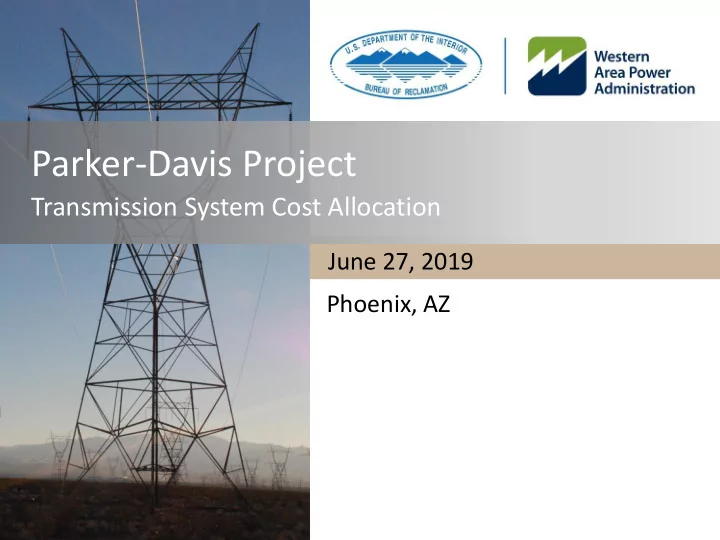

Parker-Davis Project Transmission System Cost Allocation June 27, 2019 Phoenix, AZ
Cost Allocation & Sub-Allocation • Cost allocation is the process of assigning the repayment of capital costs to each function in a multiple-purpose project • Project purposes are derived from Reclamation Law and project-specific authorizing legislation • Sub-allocations further delineate project costs between sub-purposes, for example between irrigation and municipal water users sharing a common facility 2
The 1962 P-DP Cost Allocation • Approved by Commissioner of Reclamation • Allocated costs to the Mexican Water Treaty and to power using the Separable Costs-Remaining Benefits (SCRB) method • Sub-allocated capital costs to irrigation pumping and to commercial power using the Use-of-Facilities method • Formulas based on project pumping needs relative to total transmission line capacity • To be repaid without interest from power and transmission revenues • Individual segments of line bear different ratios • Costs of Parker-Gila 161-kV lines are currently allocated 23.1% to irrigation pumping 3
Visual Structure of Cost Allocation Project Costs Separable Costs – Remaining Benefits Treaty Power Deliveries Use of Facilities Preference Irrigation Power* Power Interest- Non-Interest- Bearing Bearing Repayment Repayment 4
Use of Facilities: Capacity Use Formula • For each line segment: Priority Use Power Summer ACROD = Capacity Use by Irrigation Total Transfer Capability • Capacity Use by Irrigation (%) is multiplied by the cost of a feature, and that product is the cost allocated to irrigation • Update is a collaborative effort by WAPA and Reclamation 5
Cost Allocation Updates • The 1962 capacity use formulas have become outdated because: • Transmission system capacity reserved for irrigation use was increased and quantified in 1996 by contracts among Reclamation, WAPA, and project use power beneficiaries • Transmission system capacity is continually changing as WAPA upgrades or replaces transmission features • Updates to sub-allocation formulas are effective in 2019 and as future capital becomes repayable – not retroactively • Sub-allocation formulas will be reviewed annually or as transmission features are upgraded/replaced 6
Sub-Allocated Facilities • Facilities: • Davis Dam powerplant and switchyard • Transmission lines from Davis Substation to Parker Substation • Transmission lines south of Parker Substation to Gila Substation and beyond • Same facilities as 1962; however, formulas are now in greater detail. For example: • Previously, transmission line from Davis Substation to Parker Substation was one formula • Now, Davis Substation to Topock Substation and Topock Substation to Parker Substation are separate formulas 7
Upcoming Facilities Replacements Planned Transmission Line Replacements - October 2018 10-Year Plan: • Gila-Dome Tap • Kofa-Dome Tap • Parker-Blythe • Bouse Upgrade Project 8
Example: Gila-Dome Tap Replacement • Estimated cost is $7,600,000 • Construction in 2019-2020, financial close-out 2020 • Lines serve Priority Use Power (irrigation) and Firm Electric Service/Transmission (commercial) customers • Costs must be allocated between the respective purposes • If we make no change, 23.1% of costs will be non- interest-bearing in accordance with 1962 allocation for Parker-Gila • Updated non-interest-bearing allocation for Gila-Dome Tap segment is estimated at 24.3% 9
Firm Electric/Transmission Rate Impact • Changes in sub-allocations vary based on facility – both increases and decreases • These changes will result in more or less capital costs becoming interest-bearing • To be conservative, rate calculations have assumed all future capital costs are interest-bearing • As such, while changes in the sub-allocation may make more capital costs interest-bearing, it will be less than what is included in rate calculations 10
Priority Use Power Rate Impact • Rather than only affecting the amount of capital repaid with interest, the changes will affect the amount of capital included in the Priority Use Power (PUP) rate • The Aggregate Power Managers pay the Firm Electric Service Rate for PUP • The PUP rate is used by the Aggregate Power Managers in their arrangements with other PUP customers • Outdated sub-allocations will affect the Aggregate Power Managers and PUP customers 11
Draft Cost Allocation Documents https://www.wapa.gov/regions/DSW/Rates/Pages/rates.aspx 12
Summary • The 1962 sub-allocation formulas for irrigation and commercial power/transmission are being updated and will be effective in 2019 • The existing formulas are outdated due to changes in irrigation usage and system capacity • FES/Transmission Rate: • Change the amount of capital costs that are interest-bearing • Rates have assumed all future capital costs are interest- bearing • PUP Rate: Change the amount of capital costs included in the rate – not just the amount that is interest- bearing 13
Questions or Suggestions Lesli Kirsch-Burke, Economist Lkirsch@usbr.gov (702) 293-8322 Scott Lund, Project Manager slund@wapa.gov (602) 605-2442 14
Recommend
More recommend